9th United States Congress
The 9th United States Congress was a meeting of the legislative branch of the United States federal government, consisting of the United States Senate and the United States House of Representatives. It met in Washington, D.C. from March 4, 1805, to March 4, 1807, during the fifth and sixth years of Thomas Jefferson's presidency. The apportionment of seats in the House of Representatives was based on the Second Census of the United States in 1800. Both chambers had a Democratic-Republican majority.
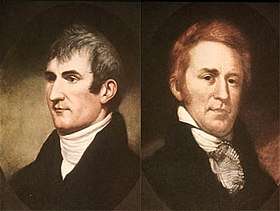
| 9th United States Congress | |
|---|---|
8th ← → 10th | |
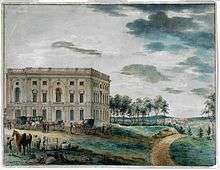 United States Capitol (1800) | |
| March 4, 1805 – March 4, 1807 | |
| Senate President | George Clinton (DR) |
| Senate President pro tem | Samuel Smith (DR) |
| House Speaker | Nathaniel Macon (DR) |
| Members | 34 senators 142 members of the House 3 non-voting delegates |
| Senate Majority | Democratic-Republican |
| House Majority | Democratic-Republican |
| Sessions | |
| Special: March 4, 1805 – March 4, 1805 1st: December 2, 1805 – April 21, 1806 2nd: December 1, 1806 – March 4, 1807 | |
Major events
- June 1, 1805: First Barbary War ends.
- November 7, 1805: Lewis and Clark Expedition arrived at the Pacific Ocean.
- September 23, 1806: Lewis and Clark Expedition returned to St. Louis, Missouri, thereby ending the exploration of the Louisiana Territory and the Pacific Northwest.
- February 19, 1807: Former Vice President Aaron Burr was tried for conspiracy and acquitted.
Major legislation
- March 29, 1806 - Cumberland Road, ch. 19, 2 Stat. 357
- February 24, 1807 - Seventh Circuit Act of 1807, ch. 16, (2 Stat. 420)
- March 2, 1807 - Act Prohibiting Importation of Slaves, ch. 22, 2 Stat. 426
- March 3, 1807 - Insurrection Act, ch. 39, 2 Stat. 443
Territories organized
- June 30, 1805 Michigan Territory was formed from a portion of the Indiana Territory
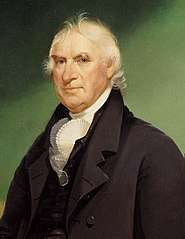
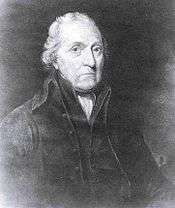
Samuel Smith (DR)
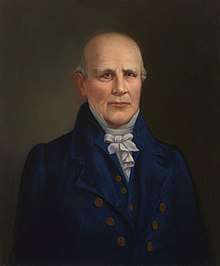
Nathaniel Macon (DR)
Party summary
The count below identifies party affiliations at the beginning of the first session of this Congress. Changes resulting from subsequent replacements are shown below in the "Changes in membership" section.
Senate
| Party (shading shows control) |
Total | Vacant | ||
|---|---|---|---|---|
| Democratic- Republican (DR) |
Federalist (F) | |||
| End of previous congress | 25 | 9 | 34 | 0 |
| Begin | 26 | 7 | 33 | 1 |
| End | ||||
| Final voting share | 78.8% | 21.2% | ||
| Beginning of next congress | 28 | 6 | 34 | 0 |
House of Representatives
| Party (shading shows control) |
Total | Vacant | ||
|---|---|---|---|---|
| Democratic- Republican (DR) |
Federalist (F) | |||
| End of previous congress | 102 | 39 | 141 | 1 |
| Begin | 113 | 26 | 139 | 3 |
| End | 112 | 28 | 140 | 2 |
| Final voting share | 80.0% | 20.0% | ||
| Beginning of next congress | 115 | 25 | 140 | 1 |
Leadership
Senate
- President: George Clinton (DR)
- President pro tempore: Samuel Smith (DR)
House of Representatives
- Speaker: Nathaniel Macon (DR)
Members
This list is arranged by chamber, then by state. Senators are listed by class, and Representatives are listed by district.
Senate
Senators were elected by the state legislatures every two years, with one-third beginning new six-year terms with each Congress. Preceding the names in the list below are Senate class numbers, which indicate the cycle of their election.
Connecticut
Delaware
Georgia
Kentucky
Maryland
Massachusetts
New Hampshire
New Jersey
|
New York
North Carolina
Ohio
Pennsylvania
Rhode Island
South Carolina
Tennessee
Vermont
Virginia
|
House of Representatives
The names of members of the House of Representatives are listed by their district numbers
ConnecticutAll representatives were elected statewide on a general ticket.
Delaware
GeorgiaAll representatives were elected statewide on a general ticket.
Kentucky
MarylandThe 5th district was a plural district with two representatives.
Massachusetts
New HampshireAll representatives were elected statewide on a general ticket.
New JerseyAll representatives were elected statewide on a general ticket.
New York
|
North Carolina
Ohio
PennsylvaniaThere were four plural districts, the 1st, 2nd, & 3rd had three representatives each, the 4th had two representatives.
Rhode IslandBoth representatives were elected statewide on a general ticket.
South Carolina
Tennessee
Vermont
Virginia
Non-voting members
|
Changes in membership
The count below reflects changes from the beginning of this Congress.
Senate
| State (class) |
Vacator | Reason for change | Successor | Date of successor's formal installation[lower-alpha 1] |
|---|---|---|---|---|
| North Carolina (2) |
Vacant | Montfort Stokes (DR) was elected in 1804 but declined the position. Successor elected December 22, 1805. |
James Turner (DR) | Seated December 22, 1805 |
| Kentucky (3) |
John Breckinridge (DR) | Resigned August 7, 1805, after being appointed United States Attorney General. Successor elected November 8, 1805, to finish the term ending March 4, 1807. |
John Adair (DR) | Seated November 8, 1805 |
| Georgia (3) |
James Jackson (DR) | Died March 19, 1806. Winner elected June 19, 1806, to finish the term ending March 4, 1807. |
John Milledge (DR) | Seated June 19, 1806 |
| Maryland (3) |
Robert Wright (DR) | Resigned November 12, 1806, after being elected Governor of Maryland. Successor elected November 25, 1806, to finish the term ending March 4, 1807 (as well as to the next term). |
Philip Reed (DR) | Seated November 25, 1806 |
| Kentucky (3) |
John Adair (DR) | Resigned November 18, 1806, after losing the election to the next term. Successor elected November 19, 1806, despite being younger than the constitutional age minimum. |
Henry Clay (DR) | Seated November 19, 1806 |
| North Carolina (3) |
David Stone (DR) | Resigned February 17, 1807. Vacant for remainder of Congress. |
Vacant |
House of Representatives
| District | Vacator | Reason for change | Successor | Date of successor's formal installation[lower-alpha 1] |
|---|---|---|---|---|
| Connecticut At-large |
Vacant | Calvin Goddard (F) resigned before the beginning of this Congress | Timothy Pitkin (F) | Seated September 16, 1805 |
| Connecticut At-large |
Vacant | Roger Griswold (F) resigned before the beginning of this Congress | Lewis B. Sturges (F) | Seated September 16, 1805 |
| Pennsylvania 11th |
Vacant | John B. C. Lucas (DR) resigned before the beginning of this Congress | Samuel Smith (DR) | Seated November 7, 1805 |
| Pennsylvania 4th |
John A. Hanna (DR) | Died July 23, 1805 | Robert Whitehill (DR) | Seated November 7, 1805 |
| North Carolina 10th |
Nathaniel Alexander (DR) | Resigned November, 1805 after being elected Governor of North Carolina | Evan S. Alexander (DR) | Seated February 24, 1806 |
| Indiana Territory | Vacant | Territory elected delegate to Congress for first time | Benjamin Parke | Elected December 12, 1805 |
| Georgia At-large |
Cowles Mead (DR) | Lost contested election December 24, 1805 | Thomas Spalding (DR) | Seated December 24, 1805 |
| Georgia At-large |
Joseph Bryan (DR) | Resigned sometime in 1806 | Dennis Smelt (DR) | September 1, 1806 |
| Georgia At-large |
Thomas Spalding (DR) | Resigned sometime in 1806 | William W. Bibb (DR) | Seated January 26, 1807 |
| Pennsylvania 1st |
Michael Leib (DR) | Resigned February 14, 1806 | John Porter (DR) | Seated December 8, 1806 |
| Maryland 7th |
Joseph H. Nicholson (DR) | Resigned March 1, 1806 | Edward Lloyd (DR) | Seated December 3, 1806 |
| Virginia 13th |
Christopher H. Clark (DR) | Resigned July 1, 1806 | William A. Burwell (DR) | December 1, 1806 |
| Connecticut At-large |
John Cotton Smith (F) | Resigned sometime in August, 1806 | Theodore Dwight (F) | December 1, 1806 |
| Territory of Orleans | Vacant | Territory elected delegate to Congress for first time | Daniel Clark | Elected December 1, 1806 |
| Pennsylvania 3rd |
Christian Lower (DR) | Resigned December 19, 1806 | Vacant | Not filled for remainder of term |
| South Carolina 6th |
Levi Casey (DR) | Died February 3, 1807 | Vacant | Not filled for remainder of term |
Committees
Lists of committees and their party leaders.
Senate
- Army Regulations (Select)
- Whole
House of Representatives
- Accounts (Chairman: Frederick Conrad)
- Claims (Chairman: John C. Smith then David Holmes)
- Commerce and Manufactures (Chairman: Jacob Crowninshield)
- Elections (Chairman: William Findley)
- Public Lands (Chairman: Andrew Gregg then John Boyle then Andrew Gregg)
- Revisal and Unfinished Business (Chairman: Samuel Tenney)
- Rules (Select)
- Standards of Official Conduct
- Ways and Means (Chairman: John Randolph then Joseph Clay)
- Whole
Joint committees
- Enrolled Bills (Chairman: N/A then Sen. James Turner)
- The Library (Chairman: N/A)
Employees
Legislative branch agency directors
- Architect of the Capitol: Benjamin Latrobe
- Librarian of Congress: John J. Beckley
Senate
- Chaplain: Alexander T. McCormick, Episcopalian, elected November 7, 1804
- Edward Gantt, Episcopalian, elected December 4, 1805
- John J. Sayrs, Episcopalian, elected December 3, 1806
- Secretary: Samuel A. Otis
- Sergeant at Arms: James Mathers
House of Representatives
- Chaplain: James Laurie, Presbyterian, elected December 2, 1805
- Robert Elliot, Presbyterian, elected December 1, 1806
- Clerk: John Beckley
- Doorkeeper: Thomas Claxton
- Reading Clerks: [data unknown/missing]
- Sergeant at Arms: Joseph Wheaton
See also
- 1804 United States elections (elections leading to this Congress)
- 1806 United States elections (elections during this Congress, leading to the next Congress)
Notes
- This is the date the member was seated or an oath administered, not necessarily the same date her/his service began.
References
- Martis, Kenneth C. (1989). The Historical Atlas of Political Parties in the United States Congress. New York: Macmillan Publishing Company.
- Martis, Kenneth C. (1982). The Historical Atlas of United States Congressional Districts. New York: Macmillan Publishing Company.